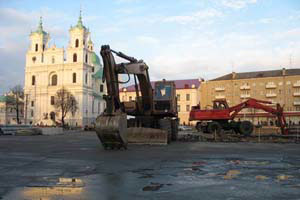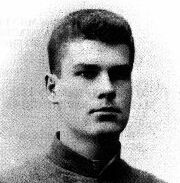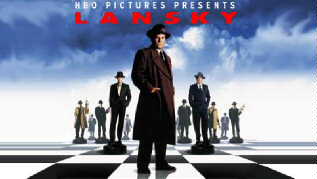
Dear friends,
Welcome to Hrodna page. I can talk endlessly about Hrodna - my home city. But here are some facts and pictures.

Dear friends,
Welcome to Hrodna page. I can
talk endlessly about Hrodna - my home city. But here are some facts and
pictures.
 |
ALERT! Hrodna gives an example of the worst act of vandalism in post-war Europe. The buildings of historical center of Hrodna that survived 2 World Wars and Soviets are being demolished by bureaucrats of Lukashenka regime. The regime "improves" this historically green and cozy town by cutting down old trees and widening narrow streets of old town into a tasteless soviet-style prospects. This of course puts centturies old architecture in their way. Citizen of Hrodna unite in their struggle to defend their beloved town vandalized by mindless regime of Lukashenka and its functionaries. |
Hrodna youth is conducting flash mob with the portraits of Hrodna executives who destroy Hrodna:

The first mention of Hrodna (Grodno in Russian and Horadnya in old Belarusian) appeared in 1128 A.D. in the Ipat'ev Chronicle. The name of the city stems from the eastern Slavonic work for town, "gorod," and refers to a "fenced settlement." Hrodna was founded on a high hill overlooking the confluence of the rivers Nyoman and Hradnichanka. Located today in Belarus ("White Rus'") it was a center of Chornaia Rus' ("Black Rus") until the early 13th century.
 The symbol of Hrodna since
XVI is St. Kazimir's Deer jumping over the fence.
The symbol of Hrodna since
XVI is St. Kazimir's Deer jumping over the fence.
Apparently, St. Kazimir was a saint of hunters and the very first nature conservationist!
An avid hunter he stopped hunting and sworn to protect Nature when a deer with a
golden cross between horns miraculously appeared in front of him during his last
hunt.
In 1496 Hrodna was awarded a Magdeburg "Right" to promote
its economy and the 500th anniversary of that important event was celebrated in 1996.
From the second half of the XII Century Hrodna was part of the Grand Duchy of
Lithuania,
and in 1569 it merged with the Kingdom of Poland to form Rzech Pospolita
Polsko-Litewska - the Commonwealth of Poland and Lithuania. The name Belarus appears only
later. During the period of the Vitaut Duchy and the reign of King Stefan Batory of Rzhech
Pospolita Hrodna was their residence and the capital of entire state.
In 1588, there were two castles in Hrodna, nine Orthodox and three
Catholic churches, one synagogue, 31 streets and 4,000 inhabitants.
Between 1760 and 1780 the
major of Hrodna, Antonij Tyzenhaus, founded a number of royal manufacturing businesses. Also, during that period there was a medical
academy in Hrodna with Dr. Jan Emmanuel Giliber, a French surgeon and botanist, serving as
rector. He founded the botanical garden in Hrodna which at the time was considered the
best in Europe. The Central City Park is located now in place of his garden.
In 1795 Hrodna was incorporated into the Russian Empire. Hrodna
was occupied in 1812 as Napoleon's Army marched toward Moscow. It was liberated in the
wake of Napoleon's defeat.
 Famous Belarusian
poet Maksim Bahdanovich was living in Hrodna. His house is nowadays a museum of
Bahdanovich.
Famous Belarusian
poet Maksim Bahdanovich was living in Hrodna. His house is nowadays a museum of
Bahdanovich.
Hrodna was in the front lines of World War I. From September of 1915 it
was occupied by the German Army. In the subsequent turmoil caused by the end of the war
and the onset of the Russian Revolution Hrodna was captured by the Pilsudski Army in 1920,
was ceded to Poland by the Treaty of Riga and remained part of Poland until 1939.
In September 1939 Poland has been occupied and divided between Nazi
Germany and USSR according to Ribbentrop-Molotov agreement. At this time Western Belarus
(including Hrodna) rejoined Eastern Belarus (BSSR).
At the beginning of the Nazi attack on the USSR, June 22, 1941, Hrodna
was bombed by the Luftwaffe. It was occupied the next day by the Nazi Army. My Grandmother
stayed in fascist occupation with my Mother and Aunt (6 and 5 year old girls) for three
long years. Hrodna buildings did not suffer the massive destruction during the war - the
fate of other major cities between Berlin and Moscow. The population, however, did suffer
at Nazi hands, especially the Jews who had lived in three large ghettos. The population of
Hrodna decreased more than in half - from 57,200 in 1939 to 25,000 in 1944.
The Soviet Army liberated Hrodna from Nazis in 1944. Most of the
battles were conducted on the banks of Nioman outside the city. There were no battles in
the streets. My Grandmother told me that one day she simply saw a lone Russian soldier
walking down the street and started to cry out in happiness. She was hiding with her
daughters for two last weeks under the bridge listening to approaching cannonade,
because fascists were executing people from their black lists and destroying strategically
important objects before their retreat.
Ever since, Hrodna has been a part of Belarus. Many of the old churches
survived the war and the destruction of the Nazis, but in the late 1950s the huge XIV
Century "Garrison Catholic Church" was criminally destroyed by they Soviets in
their effort to stamp out religion. Today Hrodna has more of the old architecture
than any
other Belarusian city.
Since the breakup of the Soviet Union in 1990 Belarus has been an independent
country.
Timeline of Hrodna Rulers
At different times Hrodna area belonged:
Here is how Hrodna population has grown over the centuries (in thousands):
Hrodna has 109
enterprises: 31 - state, 10 - joint stock, 21 - joint ventures with foreign capital, 47 -
of middle and small business. The biggest companies are "Azot" (chemical
products, nitric fertilizers), "Himvolokno" (synthetic fiber),
"Radiowave" (electronics), two fabric manufacturing companies
"Pryadil'no-Nitochnyj Kombinat" and "Tonko-sukonnyj Kombinat".
The major products manufactured in Hrodna are: mineral fertilizers, TV
sets, best portable radio's in former USSR - "Okean", auto cassette tape
recorders, fibers and fabrics, clothes, cigarettes, shoes, tools, automotive products.
There are 836 shops in the city: 194 - state, 642 - private.
Our train station is a very busy place. Some 65 trains arrive from or depart to Moscow, St. Petersburg, Minsk, Vilnius, Warsaw and other cities daily. The municipal airport is some 10 miles from the city center, near the city of Abuhava, and has a modern runway upon which the largest or planes, even the Space Shuttle, can land :-) But ever since "Perestroika" began there are no regular flights from or to Hrodna. People can not afford it. During USSR times not only Hrodna, but each of the regional centers in Hrodna Voblasc' was accessible by plane everyday. Today the most convenient and safe way to get around within Belarus are the inter-city busses. 60 - 85 of them are leaving Hrodna every day to Russia, Ukraine, Lithuania, Poland, Latvia.
__Map of Hrodna (~1985, in Russian)
 The largest educational institutions in Hrodna are Kupala University (older
webpage), Hrodna State Medical Institute and the Hrodna State Agricultural Institute.
There are also seven technical colleges and 10 professional schools in the city.
The largest educational institutions in Hrodna are Kupala University (older
webpage), Hrodna State Medical Institute and the Hrodna State Agricultural Institute.
There are also seven technical colleges and 10 professional schools in the city.
Institute of Biochemistry of the Belarus Academy of Sciences, which was founded by the academician Ostrovski, is located in Hrodna, as is the Division of Economics of Natural Resources. Two academicians, 84 doctors habilitats and 569 Ph.Ds. live in Hrodna.
All children from six years old to 16 must
attend school. There are 47,200 pupils in attendance at 38 schools in Hrodna. Take a look
at the picture tour of
Hrodna made from the drawings of children from school #30 in Hrodna. It was published
in the MidLink Magazine on
the Global Skylines
page.
There are many libraries in Hrodna. The biggest and oldest is the Hrodna Public Library
which is named after the academician E. Karski.

Hosting me - with my comments or only the pictures

These old photos were used to recreate an atmosphere of 1910 Hrodna for an HBO original movie "Lansky" which premiered on HBO on Saturday, February 27, 1999. The movie is about the famous American mobster - David Meyer Lansky, originally born in Hrodna in 1902 and then emigrated with his parents to USA.

![]() Grodno.by - The page is maintained by a local telephone company and has an on-line Hrodna
telephone directory, schedules of trains, planes and busses to and from Hrodna, and much
more up-to-date information. The only drawback is that not all of the page has been
translated into English.
Grodno.by - The page is maintained by a local telephone company and has an on-line Hrodna
telephone directory, schedules of trains, planes and busses to and from Hrodna, and much
more up-to-date information. The only drawback is that not all of the page has been
translated into English.
![]() Official
site of Hrodna Administration - information on Hrodna and all regional
centers of Hrodna Voblasc'
Official
site of Hrodna Administration - information on Hrodna and all regional
centers of Hrodna Voblasc'
![]() Hrodna.by
- "Hrodna On-Line" regional information center
Hrodna.by
- "Hrodna On-Line" regional information center
![]() Grodno-online
- Jewish history of Hrodna.
Grodno-online
- Jewish history of Hrodna.
![]() See also History
of Grodna page by Ellen Sadove Renck at Jewishgen.com
See also History
of Grodna page by Ellen Sadove Renck at Jewishgen.com
![]() Kupala University, Hrodna - includes
on-line university newspaper.
Kupala University, Hrodna - includes
on-line university newspaper.
![]() Hrodna
Medical State University - former Hrodna State Medical Institute.
Hrodna
Medical State University - former Hrodna State Medical Institute.
![]() Hrodna
State Agrarian University - former Hrodna State Agricultural Institute
Hrodna
State Agrarian University - former Hrodna State Agricultural Institute
![]() A tour of Hrodna from Midlink Magazine
A tour of Hrodna from Midlink Magazine
![]() A page about Hrodna in Belarusian!
from the Netherlands by Guido Thieme, who was teaching for one year in the school there.
A page about Hrodna in Belarusian!
from the Netherlands by Guido Thieme, who was teaching for one year in the school there.
![]() Hrodna
Airport site
Hrodna
Airport site
![]() National
Historical Archives in Hrodna
National
Historical Archives in Hrodna
![]() Polish version of the history of
Hrodna from Kresy site.
Polish version of the history of
Hrodna from Kresy site.
![]() Hrodna
pages at Virtual Tourist
Hrodna
pages at Virtual Tourist
![]() Hrodna
suburban railway stations map from parovoz.com
Hrodna
suburban railway stations map from parovoz.com
![]() One
more Hrodna- On-line. Somebody stop this!
One
more Hrodna- On-line. Somebody stop this!
![]() Hrodna
city portal - news, student life related.
Hrodna
city portal - news, student life related.
 This file is a part of the Virtual
Guide to Belarus - a collaborative project of Belarusian
scientists and professionals abroad. VG brings you the most extensive
compilation of the information about Belarus on the Web.
This file is a part of the Virtual
Guide to Belarus - a collaborative project of Belarusian
scientists and professionals abroad. VG brings you the most extensive
compilation of the information about Belarus on the Web.
Please send your comments to the authors of VG to
Belarus
History | Statehood | Culture | Law
and Politics | Cities | Nature and Geography |
©1994-05 VG to Belarus
Disclaimer
This page is part of the Virtual Guide to Belarus - a collaborative project of Belarusian scientists abroad Go to Belarusian towns, cities and several villages - Go to Belarusian Heritage main page © 1995-2005 VG |
 |